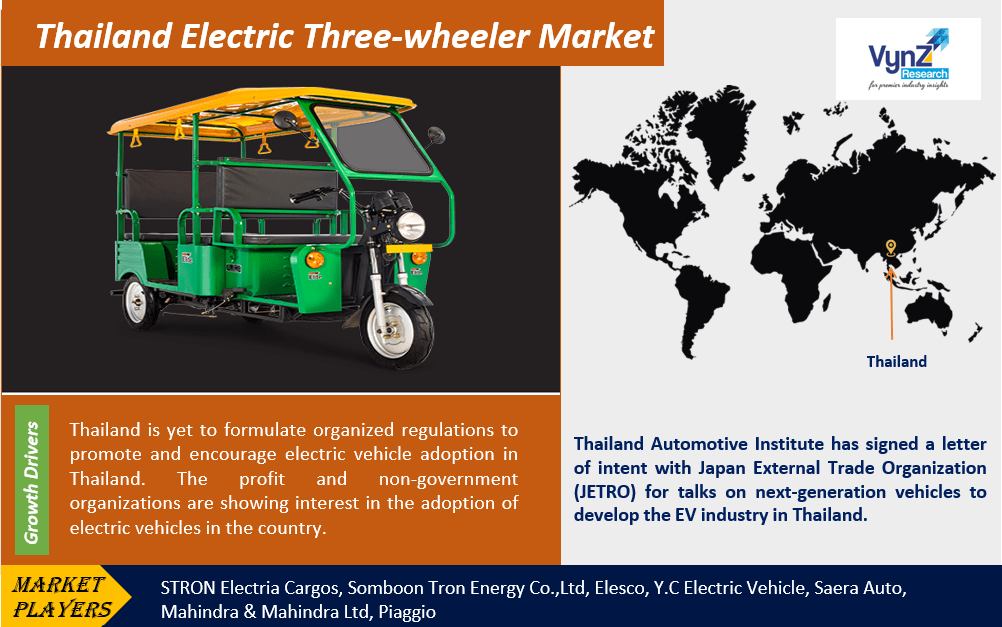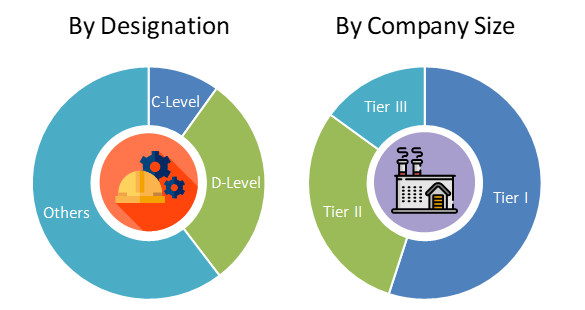Thailand Electric Three-wheeler Market Size & Share | Growth Forecast Report 2030
Industry Insights by Product (E-rickshaw, E-auto, Others), by Type (Passenger Vehicle, Load Carrier), by Motor Power (<1000 W, 1000-1500 W, >1500 W), by Driving Range (Less than 50 miles, 50-100 miles and Above 100 miles) and by Geography (Thailand)
| Status : Published | Published On : Nov, 2024 | Report Code : VRAT4058 | Industry : Automotive & Transportation | Available Format :

|
Page : 95 |
Thailand Electric Three-wheeler Market Size & Share | Growth Forecast Report 2030
Industry Insights by Product (E-rickshaw, E-auto, Others), by Type (Passenger Vehicle, Load Carrier), by Motor Power (<1000 W, 1000-1500 W, >1500 W), by Driving Range (Less than 50 miles, 50-100 miles and Above 100 miles) and by Geography (Thailand)
Industry Overview
The Thailand Electric Three-Wheeler Market is predicted to grow at 43.3% CAGR during the forecast period, in terms of its fleet size.

The Thailand market is anticipated to grow in the coming years because non-government organizations are supporting and fueling electric vehicle adoption.
Thailand Electric Three-wheeler Market Report Coverage
|
Report Metric |
Details |
|
Historical Period |
2020 - 2024 |
|
Base Year Considered |
2025 |
|
Forecast Period |
2026 - 2035 |
|
Market Size in 2025 |
U.S.D. XX Billion |
|
Revenue Forecast in 2035 |
U.S.D. XX Billion |
|
Growth Rate |
43.3% |
|
Segments Covered in the Report |
By Product, By Type, By Motor Power and By Driving Range |
|
Report Scope |
Market Trends, Drivers, and Restraints; Revenue Estimation and Forecast; Segmentation Analysis; Impact of COVID-19; Companies’ Strategic Developments; Market Share Analysis of Key Players; Company Profiling |
|
Regions Covered in the Report |
Thailand |
Thailand Electric Three-Wheeler Industry Dynamics
Thailand Electric Three-Wheeler Market Trends / Growth Drivers
The profit and non-government organizations are showing interest in the adoption of electric vehicles in the country; thus initiating programs to support and create an optimistic environment for the industry players to invest in the Thailand electric vehicle industry. This is expected to directly support the growth of the electric three-wheelers market in the country. Moreover, the government in Thailand has started taking initiatives to support the growth of the electric vehicles industry in the country. The long-term vision of the government to adopt electric vehicles as a substitute for conventional road transport will create huge traction for the global electric three-wheeler industry players and local players to invest in the Thailand market to grab the immense revenue growth opportunity. The government in Thailand plans to run 1.2 million electric vehicles and 690 charging stations in the country by 2036. The Thailand Automotive Institute has signed a letter of intent with Japan External Trade Organization (JETRO) for talks on next-generation vehicles to develop the EV industry in Thailand.
Thailand Electric Three-Wheeler Market Restraints:
High initial cost of the vehicle, limited knowledge about benefits of electric vehicles, laick of charging infrastructure are the factors hampering the growth of the electric three wheeler market in Thailand.
Thailand Electric Three-Wheeler Market Segmentation
VynZ Research provides an analysis of the key trends in each segment of the Thailand Electric Three-Wheeler Market report, along with forecasts at the regional and country levels from 2025-2030. Our report has categorized the market based on product, type, motor power and driving range.
Insight by Product
- E-rickshaw
- E-auto
- Others
Based on product, the electric three-wheelers market is segmented into e-rickshaws, e-auto, and others. E-rickshaws are the most preferred three-wheeler category. E-rickshaws are the typical three-wheelers with a top speed of around 25km/hr. These are alternatives to conventional pull rickshaws with pedals and auto rickshaws. A typical e-rickshaw carries 4+1 or 3 passengers at a time.
Insight by Type
- Passenger Vehicle
- Load Carrier
Based on type, the market is categorized into passenger vehicles and load carriers. Passenger vehicles hold a larger share of the market due to the high preference for these vehicles in intracity transport within metropolitan cities.
Insight by Motor Power
- <1000 W
- 1000-1500 W
- >1500 W
Based on motor power, the market is segmented into 1,500 W. Of all, 1,000-1,500 W powered three-wheelers hold the largest share in the Indian market. The highest share of the 1,000-1,500 W powered three-wheelers in the market is due to the optimum performance and cost of the vehicle at this power.
Insight by Driving Range
- Less than 50 miles
- 50-100 miles
- Above 100 miles
The market is segmented based on driving range, as less than 50 miles, 50-100 miles and above 100 miles. The 50-100 miles segment dominated the market during the forecast period. Developments in electric vehicles with dynamic investments by automakers and increasing concerns about environmental pollution are the major factors for the growth of the market.
Geographic Overview
Thailand
Thailand Electric Three-Wheeler Market Competitive Insight
- STRON Electria Cargos
- Somboon Tron Energy Co.Ltd
- Elesco
- Y.C Electric Vehicle
- Saera Auto
- Mahindra & Mahindra Ltd
- Piaggio
The report offers competitive insight into the players offering electric three-wheelers, OEMs or components manufacturers for these vehicles. Product and services, recent developments, and financial highlights for the players operating in the Thailand electric three-wheelers market.
Somboon Tron Energy Co.,Ltd, a manufacturer of ELECTRIA - electric 3 wheelers vehicle, provide one stop service to enhance Thailand Logistics system.
Elesco is reckoned among reliable Electric Vehicle Manufacturers in Thailand. We offer innovative and advanced e-bikes and vehicles that can redefine riding experience. Their eco-friendly nature and performance-rich design have made it highly demanded. With cutting-edge tools and modern machinery, Company has become India's most prominent Electric Vehicle dealers and suppliers designed to fit your unique requirement.
The Thailand Electric Three-Wheeler Market offers a comprehensive market segmentation analysis along with an estimation for the forecast period 2025–2030.
PRIMARY RESEARCH INTERVIEWS - BREAKDOWN

Frequently Asked Questions
Purchase Options
Latest Report
Research Methodology
- Desk Research / Pilot Interviews
- Build Market Size Model
- Research and Analysis
- Final Deliverabvle
Connect With Our Sales Team
- Toll-Free: 1 888 253 3960
- Phone: +91 9960 288 381
- Email: enquiry@vynzresearch.com
Thailand Electric Three-wheeler Market
